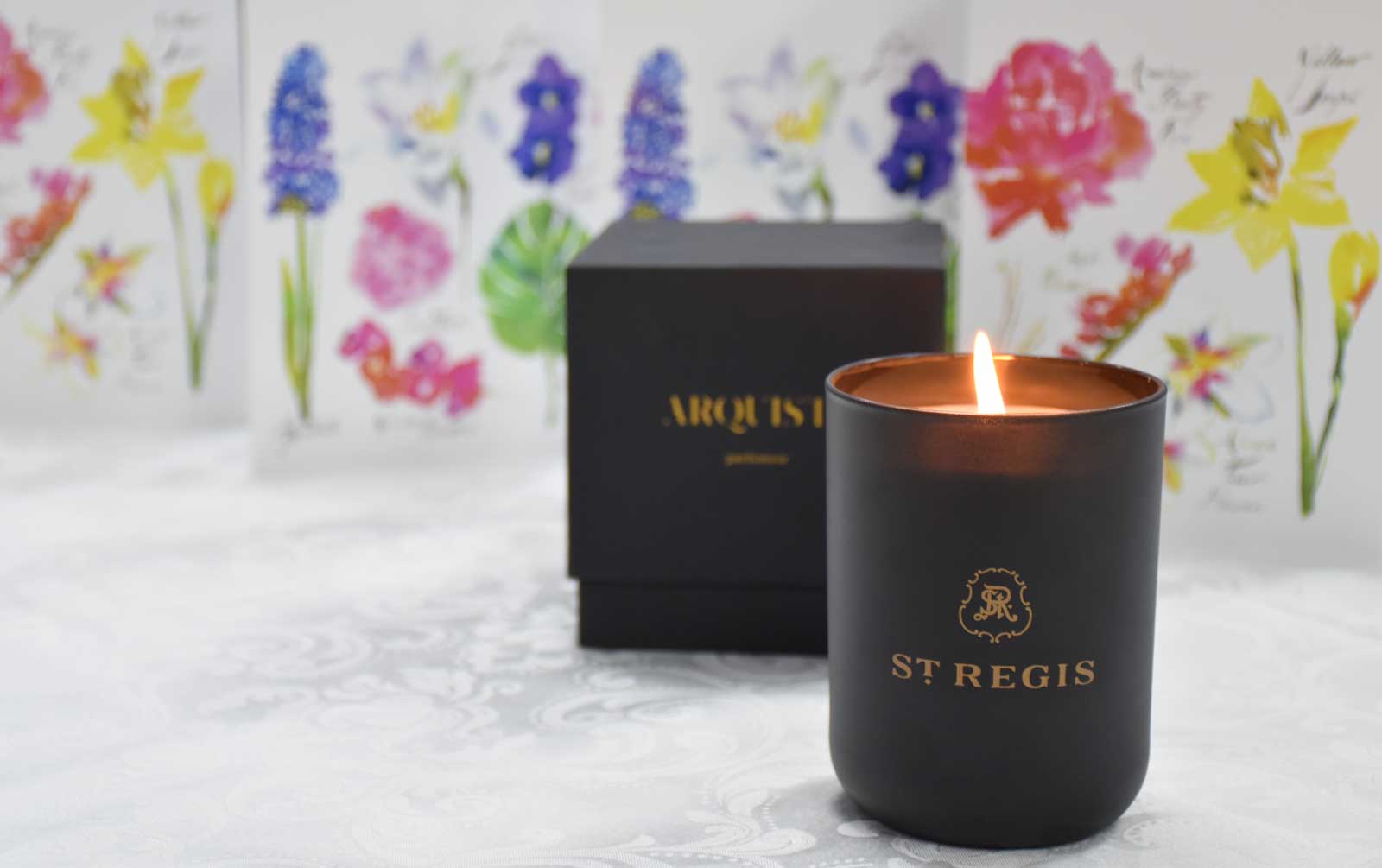“Scent has the rare ability to transport us to another time and place in the most intimate way,” says Carlos Huber, the world-renowned scent designer and founder of ARQUISTE. And Huber’s latest scent, created in collaboration with St. Regis Hotels & Resorts, aims to do exactly that.
Capturing the brand’s rich history and its modern sophistication in one olfactory experience, Huber has spent the past month travelling around the world to launch “Caroline’s Four Hundred”, now available at all of the luxury brand’s hotels and resorts around the world as a candle, with a room spray to follow this spring.
With a background in architecture and historic preservation, Huber is known for his passion of bringing historical moments to life with each ARQUISTE fragrance representing an olfactory interpretation of an incredibly detailed moment in time, such as a fiery duel in 1837 that took place between the great Russian author Alexander Pushkin and a young French officer who flirted with his wife, or the moment in 1660 when Maria Teresa, the Infanta of Spain, is offered to Louis XIV in exchange for peace between Spain and France.
Huber’s bespoke scent for St. Regis, named after the matriarch of the founding family of the original St. Regis hotel in New York and doyenne of the city’s Gilded Age society, was inspired by Caroline Astor’s most splendid balls and the 400 notable guests that represented the highest echelons of New York society.
“Caroline’s Four Hundred” candle retails for US$80 and is available for purchase on the St. Regis brand’s online retail site, www.stregis.com/boutique, as well as www.arquiste.com.

What was it like growing up in Mexico City?
It’s a great place to grow up. There are so many contrasts. A good childhood is about education and your family, but I feel there is a lot to learn from the city and the people – the beautiful values, warmth and understanding. Life is very complex. Not everything is shiny, happy, golden Swarovski crystals. It’s also really sophisticated, there’s a lot of history and richness to the culture; there’s a lot of layers to everything. It was a very interesting place to grow up and I think it’s really formed the way I am. I’m very fortunate. I’m the first one in love with my own country.
When did you first discover your love for fragrance?
I’ve always been very interested in scent, I don’t know why. My dad always wore cologne, and he was very particular about the cologne he wore. My parents also travelled a lot and they would always bring us little gifts; those little miniature sets of perfume from duty free, and it was just something that I always loved. And funnily enough, when St. Regis contacted me about creating a scent for them, I mentioned to them how one of my first memories that relates to scent has to do with a hotel. When I was 12, I travelled with my family to London and we were staying at this hotel in Mayfair. As soon as you walked in, there was something very distinctive about the scent.
I remember I always mentioned it to my dad: “What is that? What is that scent?” And my dad is an endodonist – he’s a root-canal specialist – and although he loved cologne, he didn’t know what the scent was until the last day. We were there for five days, and at the end of the stay he said: “Oh you know what? It’s the flowers.” They were Casablanca white lilies in the lobby that were scenting the entire room. Any time I walked into another hotel that had lilies, I always associated the scent with that particular hotel. And it would always make me think: this hotel is beautiful, elegant and chic. A category above, because it has that scent. There’s something about a hotel that smells like a fresh bouquet of flowers that for me is really chic. So it really was full circle. It’s one of the first memories that I have of scent.
How did your foray into the world of perfume begin?
I’ve always been sensitive to smell and serendipitously, I met this woman named Sophie Bensamour who was an evaluator – which is like a sommelier for scent. She’s not the owner of the vineyard and she’s not the winemaker but she can judge from both sides. An evaluator is the middle person between myself and the perfumer. I give the perfumer an idea, a story, they have the artistic drive or technology to make it happen and the evaluator would be able to say: “Well the client is telling me this, and you need to translate it into this.” She has the chemistry knowledge to talk to him, but also understands me being outside of the sphere. So I met Sophie in Mexico City and I said: “Wow that’s fascinating – I love scent.” Later, when I moved to New York, I was hanging out with some French friends and talking to this one guy who turns out to be a perfumer.

After asking me where I’m from he says: “Oh, I’m friends with a girl who used to live in Mexico City, she just moved here, and she’s French. And I said: “What’s her name?” and he says: “Sophie.” It was Sophie Bensamour. We all started going out to lunch together, and Sophie says: “I have to introduce you to my friend Rodrigo who is also from Mexico City.” So I meet Rodrigo [Rodrigo Flores-Roux, Givaudan] and immediately we are cracking up. He’s my best friend now. You know when you see somebody’s picture and you think: I don’t know if we would be friends? And then you meet them and you’re like – how are we not best buddies? It’s incredible. So we become good friends and I would always pester him about questions about fragrance. And he said: “If you’re really interested, I’ll give you classes.” So I did a year and a half of classes with him.
Your background is architecture – and you also seem to be quite the historian, as ARQUISTE fragrances reflect very particular moments in time. How did you begin introducing historical elements into your concepts for fragrances?
To be honest with you, I love history. I’m a sucker for anything with history. I digest it. I can go through books and books about history. I’m one of those readers that takes a long time to go through books because I really notice everything. If there’s a certain witty turn of phrase, I will reread it again and again. I like the details. Once I was taking the classes, I started picking up a lot of those details whenever I read. Anything that was an olfactory reference, or anything that was an ingredient, or if I read there was jasmine, or there was orange blossom, or there was an orangerie in Versailles, those little things started to interest me. There are times when I think this story is too intellectual, or too particular to my taste and won’t actually capture anyone else’s attention – so there are times when I think maybe this isn’t a story to tell.
But I think being in a realm that is more about artistic drive and specific points of view rather than a marketing strategy or a focus group, I’m still allowed to do whatever I want with it. The latest one is called Nanban and it’s a 17th-century voyage from Japan that carried a delegation of samurai to Mexico and Europe. They would collect all these goods and try to secure trade negotiations with the West. The Spanish and Portuguese were trading a lot with Japan and the Japanese thought: We should do the same. Japan was poor in resources at the time, but they had very great amounts of crafts that Europeans were consuming like lacquer boxes and ceramics. So it’s a concept that is quite niche and intellectual, but it has a beautiful bottom line of discovery and venturing out, going on a voyage and bringing things back with you. Everyone wants to travel, and perfume is a way to do that through your nose. Even if you are wearing something that you are used to, you are wearing it because it reminds you of a person or a place, like a hotel.

Your passion for history clearly made you the perfect match for St. Regis, then?
Firstly, it was really great that St. Regis has a history, and I was incredibly flattered when they contacted me, to be considered to create a signature scent. They explained that the brand is very tied in to the history of the New York property and the Astors, and Caroline Astor was a big reference. As the hostess, the mother and the woman, there are a lot of traditions of Caroline as a homemaker that were carried into the hospitality of the hotel – the afternoon tea, the midnight suppers, the savouring of champagne, the fact that there were always fresh flowers in her house.
All of these things are important points in the St. Regis brand, in every single property. In every property, for example, they do a champagne ritual; in every single property they serve the Bloody Mary. They are very methodical and greatly into their heritage. I think that they understand that it’s a huge advantage, especially being an American brand. They have the rare heritage of being from the New York Gilded Age. It was a very special time in American history.
Can you tell me about your research into capturing the essence of “Caroline’s Four Hundred”?
I started researching John Jacob Astor and Caroline Astor, and one of the first things that I found was a New York Times newspaper clipping from the New York Public Library from 1900. It was the social news of the ball that Caroline Astor had held the night before. She was a socialite. Imagine opening a magazine today and reading about the ball of the season. You would have mostly pictures of people and what they were wearing. But at that time, they had to describe it. For example, Madame Blah Blah was wearing a black Crepe de Chine gown.
More importantly for me, the story went on to describe all the floral arrangements around the house. How Mrs. Astor received in her drawing room where vases of American beauty roses were all around. How she received guests next to her famous portrait and they were ushered through the corridors lined with potted palms, and vases of cherry almond and quince blossom, then onto the ballroom where they were greeted by vases of daffodils and lilies and hyacinth. Can you imagine the extravagance, with every virtual flower? So that obviously caught my attention. I thought: Now that’s a perfume formula. The more I thought about it, the more it took me back to my original memory of the hotel flowers. It is exactly what a beautiful hotel should smell like. It should smell like freshly arranged flowers.

A bouquet that is always fresh; the presentation as soon as you walk in. So that’s what I suggested to St. Regis, and that’s what I think got me the job. Because not only was it a beautiful story to tell that harks back to their heritage, but it is also a story that can translate to modernity. We’re not talking about the smell of the old leather trunks that were used in the Gilded Age, this is something that was, is and will be forever. It’s also a scent that will translate really well in every single property. It doesn’t matter if you are in Moscow in the cold or in Dubai in the heat or Punta Mita in Mexico on the Pacific, there’s always the smell of flowers.
It’s very modern while being part of the St. Regis heritage and timeless. And that’s also what I do with ARQUISTE. It’s not talking about history because it’s lost and has no relevance. It’s talking about stories that we all connect with somehow. History is not a fantasy world – it’s not another planet. Things have changed, things have evolved, but there is always a thread, always a connection to your own life. I think it’s lovely to think of history of something that you can actually wear and bring to your life and it’s not just in a book or a period movie with fancy actors and accents.
Tell us about the intricacies of imbuing scents into wax. Was it a challenge to create the St. Regis candles?
Oh my god yes. I had actually developed a scent for Cire Trudon, a French candle company, and that was my first experience with wax and yes, wax is not as noble as alcohol. It really brings its own issues and business to the formula. It becomes like two big personalities fighting. You have to tweak the wax or the formula for it to work together. You also have a lot of different qualities, like soy blends, vegetable blends, paraffin, beeswax and some of it works really well for scent, some of it doesn’t. Then there’s hard blends, soft blends. So you have to decide which type you want to use, then your formula and you have to adapt. With the St. Regis scent, we’ve developed different mediums to diffuse it.
There’s a machine that will diffuse the fragrance oil in its purest form through vents – which is quite accurate and noble – we’ve created the candle, and then we’re doing a room spray, which will arrive in spring. Because of the medium, the room spray is a little fresher and greener, whereas the candle, the minute you light it, there’s a warmth you cannot ignore. I’m really proud of the St. Regis candle. It has to be an accessible scent, but it has to be sophisticated and elegant. And it is a beautiful balance of being very elegant and being a clear message – a very direct, beautiful, democratic scent. It’s both opulent and democratic. I love that.

Can you share a favourite scent from a place from your recent travels?
One of the things I love about Australia is how incredibly fragrant the cities are. There are frangipanis everywhere, magnolias, gardenia, star jasmine everywhere. I’m a sucker for gardenia. It’s my favourite flower. I love it. In Mexico City at certain traffic lights around the city, there’s a guy who would sell bunches of gardenia, and when I first drove a car at 17, I would drive past this traffic light just to buy these gardenias, to buy them for our home. And I would give them to my sister and my mum, but I would steal them and put them in my bathroom. I love gardenias. When I go to Sydney, I love going running from Potts Point to the Royal Botanic Gardens and the Opera House. There are these apartments in Woolloomooloo that always have gardenias – it’s like a wall of gardenia – and I always make sure to run there.










